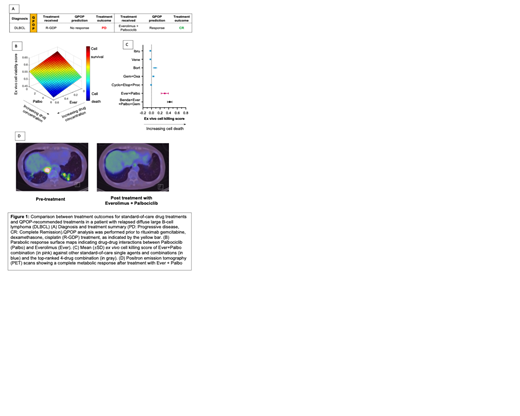Abstract
Introduction
While combination therapy is the standard of care for relapsed/ refractory non-Hodgkin lymphoma (RR-NHL), the choice of combinations for an individual patient is empirical, and response rates remain poor. Here we explore the use of a hybrid experimental/analytic method termed Quadratic Phenotypic Optimization Platform (QPOP), for prediction of optimal drug combinations from limited clinical material. This high-throughput platform identifies optimal drug-combinations on ex-vivo biopsies using an orthogonal array composite design to maximise search space. These features are potentially useful to assess personalized efficacious combinations among a set of drugs with single agent pre-clinical or clinical activity in lymphoma.
Methods
We performed a prospective cohort study of QPOP analysis in RR-NHL. Participants included RR-NHL patients across two tertiary oncology centres in Singapore, with disease amenable to biopsy or blood/ marrow aspiration, recruited between 1 st November 2017 and 5 th May 2021 - with a median follow up of 24.5 months. CD20, CD3 or CD56 selection was performed to enrich for B, T or NK cells respectively, depending on the specimen type. QPOP drug combination scores were derived from lymphoma samples (approximately 1,000,000 cells/ patient) using a matrix of drugs with known pre-clinical or clinical efficacy against NHL. Results were shared with the treating physician, and off-label QPOP-guided therapy was offered in the absence of standard options. The primary outcomes were feasibility and turnaround time of QPOP analysis. The secondary outcomes were identification of recurrent 2 and 3 drug-combinations, and concordance of QPOP results with clinical responses.
Results
In this interim analysis period, we recruited 63 patients comprising 36 B-NHL and 27 T/NK-NHL, with a median age of 57 years and median 2 prior lines of treatment. Successful QPOP analysis (Z' score >0.5) was feasible in 56/63 cases with an average turn-around time of 6 (±2.1) days. QPOP predicted frequent sensitivities to Copanlisib- and Venetoclax-based combinations in B-NHL, and Romidepsin-based combinations in T/NK-NHL. Importantly, efficacy of specific combinations was not entirely dependent on single agent dose responses. Greater variability in ex-vivo responses was seen with combinations of targeted therapy and cytotoxic therapy compared with combinations of cytotoxic agents. Clinical responses were evaluable for 29 independent treatments in 26 patients. QPOP had a positive predictive value of 60% and a negative predictive value of 78.6% with an area under the curve of 0.672 (95%CI 0.47-0.87; p=0.12) for partial response or better (n=29, p= 0.06). Complete responses were achieved with novel QPOP derived drug combinations in patients refractory to standard therapy. Examples include Palbociclib-Everolimus for diffuse large B-cell lymphoma (figure 1) and Romidepsin-copanlisib for extra nodal natural killer T-cell lymphoma.
Conclusions
Prediction of sensitivity to drug-combinations in a clinically applicable time-frame is feasible for RR-NHL cases through QPOP analysis. The relatively small number of patients treated with QPOP directed regimens makes a definitive conclusion on concordance with clinical outcomes difficult at this stage. QPOP was however able to identify novel clinically effective combinations in patients refractory to standard therapy. These data provide the basis for a prospective clinical trial evaluating QPOP based therapy in RR-NHL.
Chng: Amgen: Honoraria, Research Funding; Janssen: Honoraria, Research Funding; Celgene: Honoraria, Research Funding; Novartis: Honoraria; Abbvie: Honoraria.
everolimus palbociclib for diffuse large B cell lymphoma and rhomidepsin Bortezomib for extra nodal NK T cell lymphoma


This feature is available to Subscribers Only
Sign In or Create an Account Close Modal